Antarctica, ZE files, Navy Department Library.

The Navy Department Library
Change of Command Commander US Naval Support Force Antarctica
16 August 1985
Change of Command
Commander
U.S. Naval Support
Force
Antarctica
16 August 1985
Welcome
To
The Fifteenth
Change of Command Ceremony
Of The
Naval Support Force, Antarctica
16 August 1985
1400 Hours
Parade Field
Naval Construction Battalion Center
Port Hueneme, California
Brian H. Shoemaker
Captain, U.S. Navy
Captain Brian Shoemaker, U.S. Navy, assumed command of the U.S. naval Support Force, Antarctica on 26 July 1982. Originally from Bishop, California, he graduated from the University of California at Berkeley in 1960. He attended Pre-Flight Training as an AOC and was commissioned in august 1960 a 1350 Air Intelligence Officer. From there he attended the Naval Intelligence School, and upon graduation in 1961 was assigned to the Fleet Intelligence Center Pacific (FICPAC). He earned his wings in September 1964 and was first assigned to Helicopter Anti-Submarine Squadron THREE (HS-3) in Norfolk. In March 1966, he was transferred to Antarctic Development Squadron SIX (VX-6), where he "Wintered-Over" as Assistant Officer-in-Charge of Detachment McMurdo. After leaving VX-6 in March 1968, he was assigned to HS-1, a Fleet Replacement Squadron in Key West, Florida.
In September 1969, Captain Shoemaker entered the Naval Postgraduate School to study for his Masters of Science in Oceanography. In pursuit of thesis research he made two trips into the Central Arctic Ocean where he conducted oceanographic investigations from ice stations in the central Arctic ice pack.
After graduation from the Naval Postgraduate School, he was assigned to duty with Helicopter Anti-Submarine Squadron Light (HSL) THIRTY ONE (HSL-31) - the LAMPS program.
In September 1974, he assumed command of the Naval Arctic Research Laboratory at Barrow, Alaska. During this tour he commissioned fourteen ice stations, managed 21 field research camps around the periphery of the Arctic Ocean and supervised the drilling of an oil well as part of the Navy development of Petroleum Reserve Number Four (PET-IV).
Captain Shoemaker became Executive Officer of HSL-35 in January 1976 and "fleeted up" to Commanding Officer in January 1977. After relinquishing command of HSL-35 in April 1978, he was assigned to the staff of Commander Cruiser Destroyer Group THREE, where he deployed to the Western Pacific and Indian Oceans in 1979.
From January 1980 to May 1981 Captain Shoemaker served as the Commanding Officer of HSL-31 in San Diego, California. HSL-31 is the Fleet Readiness Squadron for replacement pilots, aircrewmen and maintenance personnel for Pacific Fleet LAMPS Squadrons. He attended the National War College, as a student prior to reporting to Naval Support Force, Antarctica.
He is married to the former Johanne Rysman of Hengelo, Holland and has two children, Robert and Ingrid.
David A. Srite
Captain U.S. NAVY
Born in Concordia, Kansas in 1938, Captain Srite graduated from Concordia High School in 1956 and then from Washburn University in 1968 with a Bachelor of Business Administration. Entering flight training through the Naval Aviation Officer Candidate Training Program at Pensacola, Florida, he was designated a Naval Flight Officer in February 1961. Captain Srite received his Master's Degree in Public Personnel Administration from Golden Gate University in 1981.
Sea duty deployments in the Pacific included a VP-48 tour to the Philippines, two Vietnam assignments in USS Hancock (CVA 19), back to the Philippines, Thailand, and Okinawa with VP-1, and VXE-6 in Antarctica as both Staff and as Commanding Officer.
Ashore, Captain Srite has served as NAS Olathe, Kansas; as a flight and ground instructor in P-3 aircraft at VP-31 NAS Moffett Field, California; Staff Member of the Naval Postgraduate School in Monterey, California; a Commanding Officer tour in Hawaii at Naval Facility, Barbers Point; and most recently on the Staff of the Commandant, Naval District, Washington, D.C.
Captain Srite has been awarded and is authorized to wear the Meritorious Services Medal with gold star, Navy Achievement Medal, National Defense Service Medal, Antarctica Service Medal, Armed Forces Expeditionary Medal (Korea) and the Vietnam Service Medal with silver star.
He is married to the former Laurel Roennigke of Bloomington, Illinois. They have one son, Mark.
NATIONAL ANTHEM
INVOCATION
FATHER GERARD CREAGH
CHAPLAIN, USN (HONORARY)
VXE-6 DRILL TEAM
REMARKS
COMMODORE ROGER L. RICH, JR., USN
ANTISUBMARINE WARFARE WINGS, U.S. PACIFIC FLEET
DR. PETER E. WILKNISS
DIRECTOR, DIVISION OF POLOAR PROGRAMS
REMARKS AND READING OF ORDERS
CAPTAIN BRIAN M. SHOEMAKER,USN
TRANSFER OF COMMAND COLORS
READING OF ORDERS AND REMARKS
CAPTAIN DAVID A. SRITE, USN
BENEDICTION
COMMANDER DONALD C. JUKAM, CHC, USN
REFRESHMENTS
Roger L. Rich, Jr.
Commodore
United States Navy
Commodore Rich entered the Navy as an Aviation Officer Candidate in March 1957 and was commissioned on 12 July 1957. His initial tours of duty after completion of flight training were with Helicopter Anti-Submarine Squadron SEVEN and Helicopter Anti-Submarine Squadron ONE.
In June 1963 Commodore Rich was selected for the U.S. Naval Test Pilot School. Upon graduation he was assigned to the Flying Qualities and Performance Branch of the Flight Test Division where he flew projects in the A-4, F-8, JRF (with hydrofoils), and VX-2 VTOL aircraft. He was subsequently selected as the principal Navy test pilot for the tri-service testing of the XC-142A VTOL transport and participated in the initial flights and development of this experimental aircraft.
Commodore Rich's next assignment was aboard the USS Raleigh (LPD-1) as Air Officer. He then attended the U.S. Air Force Command and Staff College followed by tours as Maintenance Officer Anti-Submarine Squadron SIX and as Executive Officer of Helicopter Anti-Submarine Squadron ONE. He next served as Executive Officer and Commanding Officer of Helicopter Anti-Submarine Squadron FOUR embarked in USS Kitty Hawk, when it became the first CV to make a Pacific Fleet deployment. Following assignment as a student at the Industrial College of the Armed Forces, Commodore Rich served on the staff of the Chief of Naval Operations where he managed the research and development budget for naval aviation and was a member of the V/STOL Steering Group.
His next tours were as Commanding Officer, Helicopter Anti-Submarine Wing ONE; Chief of Staff, Commander Sea-Based Anti-Submarine Warfare Wings, Atlantic; and as Commanding Officer, Naval Air Station, Jacksonville. Commodore Rich assumed command of Anti-Submarine Warfare Wing, U.S. Pacific Fleet in September 1984.
Commodore Rich, whose awards include the Legion of Merit (second award), is a 1956 graduate of the Georgia Institute of Technology where he received a Bachelor of Science Degree in Industrial Management. He also holds a Masters Degree in Business Administration from Auburn University and has earned degrees from the U.S. Naval Test Pilot School, the U.S. Air Force Command and Staff College, and the Industrial College of the Armed Forces. He has flown over 70 types of aircraft and is designated an honorary Army aviator for his contributions to Army aviation. Commodore Rich is also a member of the Society of Experimental Test Pilots.
Commodore Rich is a native of Swainsboro, Georgia and is married to the former Glynda Hatcher of Wrightsville, Georgia.
Peter E. Wilkniss
Director, Division Of
Polar Programs
National Science
Foundation
Dr. Peter E. Wilkniss became Director, Division of Polar Programs, National Science Foundation and Director, United States Antarctic Program on 8 October 1984.
The United States Antarctic Program was established to provide an effective U.S. presence in Antarctica, the principal expression of which is scientific research. The current executive agency is the National Science Foundation where program responsibility is assigned to the Division of Polar Programs.
Dr. Wilkniss has held many positions with the National Science Foundation beginning in 1975 as Manager, National Center for Atmospheric Research Program. He served as Deputy Assistant Director, Scientific, Technical and International Affairs Directorate for two years preceding his appointment to his current position.
Before joining the National Science Foundation, Dr. Wilkniss served in several positions for the U.S. Naval Research Laboratory (1966-1975), including Chairman, Radiological Committee and various positions with the U.S. Naval Ordnance Station (1961-1966) where he headed the Nuclear Chemistry Branch.
He has authored 54 articles in recognized scientific and technical journals; nine U.S. Navy reports and has given 86 formal presentations at national and international scientific conferences.
Peter Wilkniss was born 28 September 1934 in Berlin, Germany. He received an M.S. degree in Chemistry in 1958; and Ph.D. in Radio and Nuclear Chemistry in 1961, both from Technical University, Munich.
Dr. Wilkniss and his wife, Edith, live with their two children in Alexandria, Virginia.
Father
Gerard
Creagh
Chaplain,
USN (Hon
In 1967 the Navy was forced to discontinue the Catholic Chaplain position on the Naval Support Force, Antarctica due to a shortage of priests. Father Creagh, then a parish priest in Christchurch, New Zealand recognized the void and offered his assistance to coordinate Catholic chaplain services with priests from New Zealand.
Since that time New Zealand priests have provided continuous chaplain services to the Deep Freeze community during the austral summer in Antarctica; each priest sacrificing his vacation time to be part of the program established by Father Creagh.
Father Creagh, himself, has ministered for 18 years 'on the ice' at the Chapel of the Snows as well as in field camps where scientists and support personnel are working.
Father Creagh, currently the parish priest at St. Patricks Parish, Greymouth, New Zealand will deliver the invocation.
U.S. Naval Support Activity Antarctica
Command Mission and History
The U.S. Naval Support Force, Antarctica (NSFA), homeported at the Naval Construction Battalion Center Port Hueneme, California, along with the National Science Foundation and the contracted ITT Antarctic Services (ANS), maintains an active and influential United States presence in Antarctica. The Navy is responsible for providing logistical support for United States activities in the Antarctic. This year marks the 30th anniversary of deployment for NSFA.
For more than a century ships have brought whalers and explorers to the icy coastal waters of Antarctica. Shortly after 1890 interest in the Antarctic increased and continues today. The British expeditions of Capt. Robert Falcon Scott in the early 1900s were probably the most significant in establishing and maintaining scientific studies of Antarctica. Roald Amundsen of Norway became the first man to reach the South Pole in 1912. And Rear Admiral Richard E. Byrd firmly established the modern Navy in Antarctica when he made his historic flight to the South Pole in 1929.
The Naval Support Force Antarctica was established in 1954 by Rear Admiral George Dufek in Washington, D.C. to establish the base of operations and logistics for American participation in the International Geophysical Year (IGY). Officially opened on July 1, 1957, the IGY lasted for 18 months and resulted in a multitude of discoveries that revolutionized concepts of the Earth and its oceans, lands, glaciers, atmosphere, and gravitational and geomagnetic fields. It is only through the use of aircraft that man was able to make such an effective scientific probe into the continent's vast interior. The U.S. Navy's OPERATION DEEP FREEZE continues to provide America's scientists with logistic support necessary to carry out this research.
The extensive explorations of the IGY resulted in several milestones for the U.S. Naval Support Force; the first regular aircraft flights to the continent were inaugurated; massive tractor traverses were run in order to establish inland stations (Byrd Station); and an airlift by giant cargo aircraft was to be established in order to set up a station at the South Pole itself (Amundsen-Scott Station).
Since July, 1972, the National Science Foundation has been responsible for the overall management and funding of the coordinated U.S. program in Antarctica. The Division of Polar Programs acts as the coordinating agency for the United States Government in providing logistic support for our own and some foreign nations' Antarctic programs.
The Commander Naval Support Force Antarctica (CNSFA) is responsible for determining the feasibility of, and ensuring the safety and success of U.S. sponsored Antarctic Operations. He exercises operational command of about 2,000 military personnel from units of the U.S. Navy, Army, Coast Guard, the Military Sealift Command, and the Royal New Zealand Army and Air Force.
Command History Con't
Antarctic Operations
The United States operates four stations in the Antarctica which function throughout the year, and supports a number of other stations and field camps during the summer season. The austral summer season begins in late September, when the task force deploys to Antarctica, using chartered commercial aircraft and U.S. Air Force C-141 transports. After a brief stopover in Christchurch, New Zealand, the men and women of the joint and combined task force move south to "the ice" to commence an intensive period of work which takes advantage of the continual daylight from October to March. From March through September of each year the command remains at homeport in southern California, training, procuring and staging supplies and materials for the next deployment.
The largest base on the five and one-half million square mile continent is McMurdo Station, located on Ross Island some 65 miles from the continent proper. This is the main staging site for most United States operations. It is 2,250 miles south of New Zealand and 650 miles from the South Pole. McMurdo Station, the "supermarket" of the Antarctic, averages about 800 residents during its five-month summer.
The other year-round U.S. scientific stations are the Amundsen-Scott South Pole Station at the geographic South Pole; Palmer Station, on the Antarctic Peninsula off the coast of South America; and Siple Station at the foot of the Ellsworth Mountains, in Western Antarctica, Palmer and Siple Stations are manned by civilian crews.
Each year, the operation involves shipping thousands of tons of cargo, building stations or camps at remote locations and handling the deployment and redeployment of hundreds of science and support personnel to Antarctica, many to isolated research sites around the continent. In addition to providing support for stations and facilities in Antarctica which support the United States Antarctic Research Program (USARP), personnel of the Command provide communications facilities, vital weather information services, air traffic control services, air and surface operations, winter-over operations and other specialized support services.
VXE-6, the nation's only aerial support squadron participating in annual exploration and research of the frozen continent, was commissioned on January 17, 1955. The squadron's mission is to provide airlift, aerial photo-mapping services, search and rescue operations, reconnaissance support for the scientists participating in U.S. Antarctic Research Program and a wide range of related transportation services throughout Antarctica.
Cargo and fuel are transported by a Military Sealift Command cargo ship and a modern tanker, which offload at Winter Quarters Bay, McMurdo Station. Supplies are delivered during the short, relatively warm austral summer to sustain the nearly 2,000 support personnel and scientists during the operating season. Enough food and materials are also stockpiled to support about 100 men for the seven-month wintering period, when they are completely isolated from the rest of the world.
Before cargo ships can reach Antarctica, Coast Guard icebreakers must carve a channel through the frozen Ross Sea into McMurdo Sound. This channel, cut through ice sometimes 8 to 10 feet thick, usually is 15 to 20 miles long. By January the channel to McMurdo Station is open, but it is a continuing task for the icebreakers to keep the channel from refreezing so other ships can deliver their critical cargo.
Past Commanders
United States Naval Support
Force, Antarctica
| Rear Admiral George J. Dufek Feb. 1955 - April 1959 Rear Admiral David M. Tyree April 1959 - Nov. 1962 Rear Admiral Jams R. Reedy Nov. 1962 - April 1965 Rear Admiral Fred E. Bakutis April 1965 - Feb. 1967 Rear Admiral J. Lloyd Abbot, Jr. Feb. 1967 - June 1969 Rear Admiral David F. Welch June 1969 - July 1971 Captain Harry W. Swinburne, Jr. July 1971 - August 1971 August 1972 - Sept. 1972 Rear Admiral Leo B. McCuddin August 1971 - August 1972 Captain Alfred N. Fowler Sept. 1972 - June 1974 Captain Eugene W. Van Reeth June 1974 - June 1976 Captain Claude H. Nordhill June 1976 - June 1978 Captain Darrel E. Westbrook, Jr. June 1978 - June 1980 Captain jare M. Pearigen June 1980 - July 1982 Captain Brian H. Shoemaker July 1982 - August 1985 |
[END]

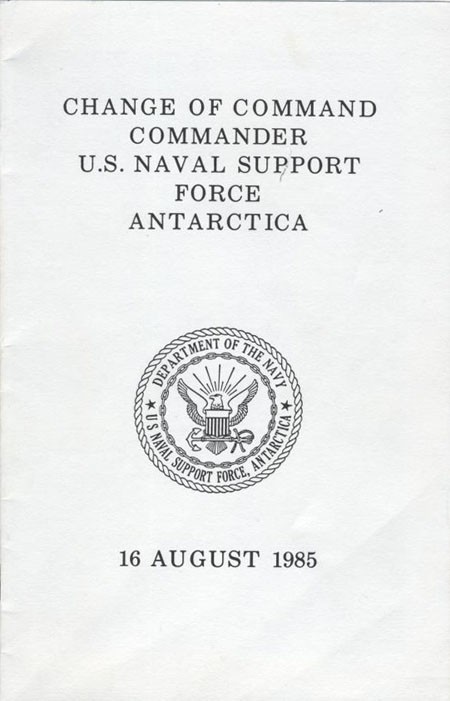
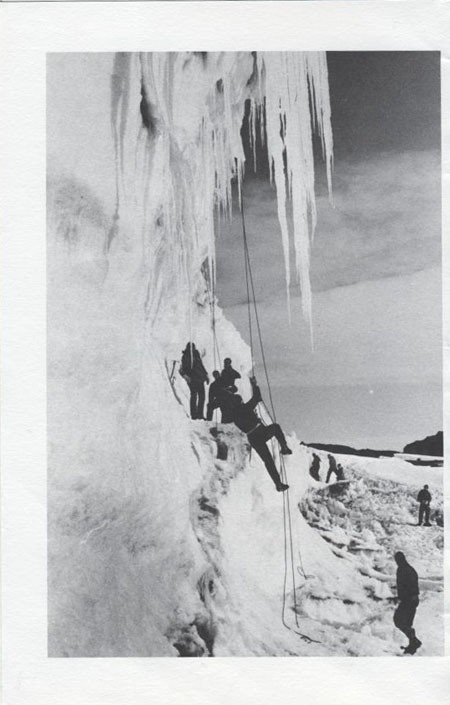
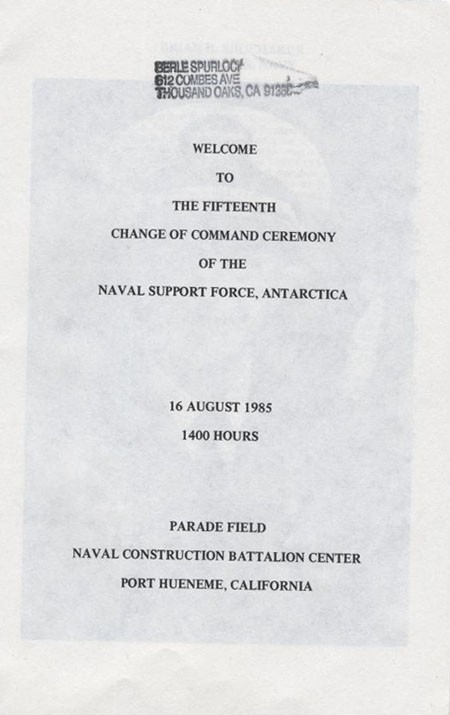
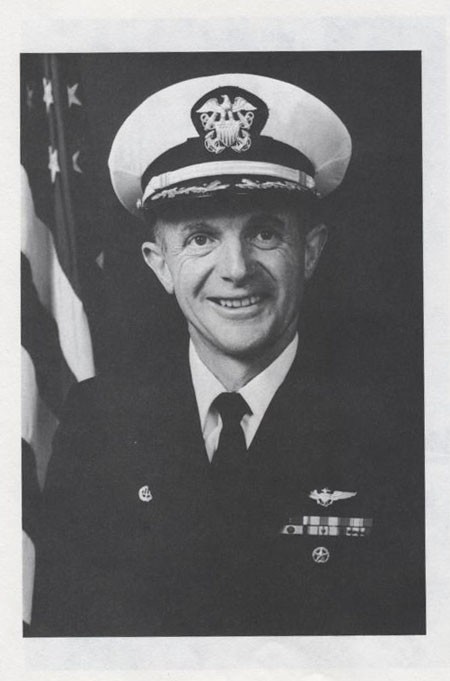
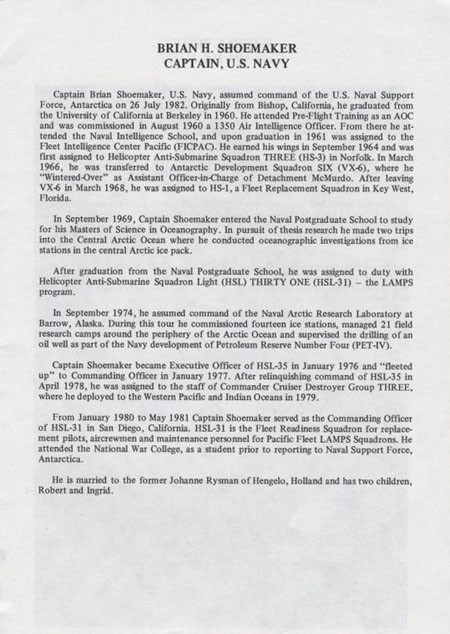
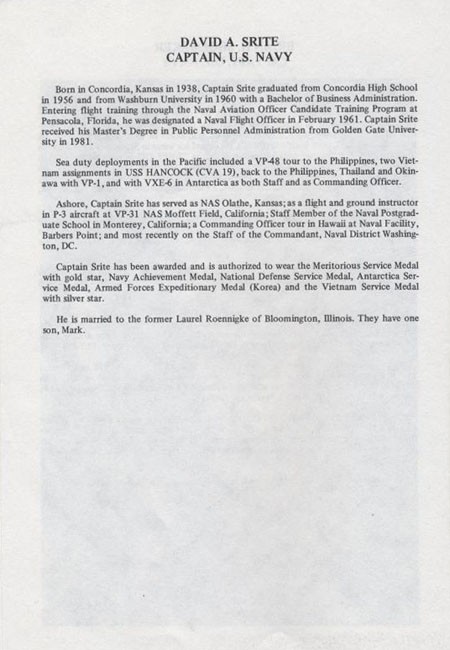
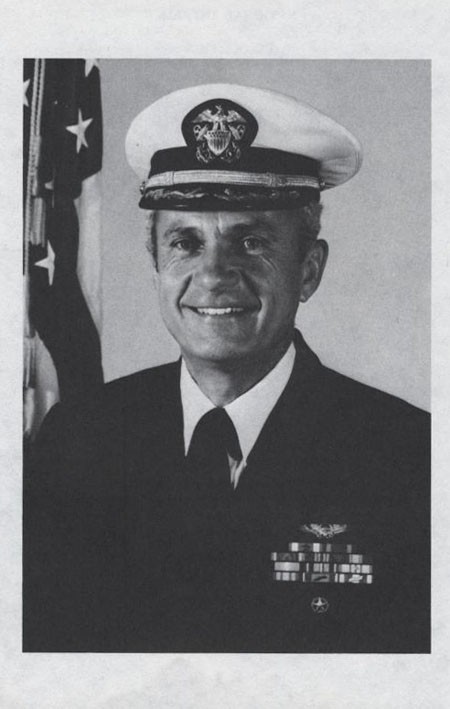
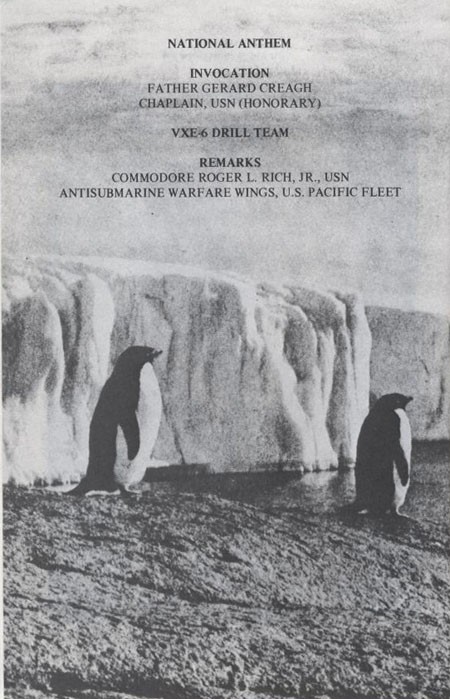
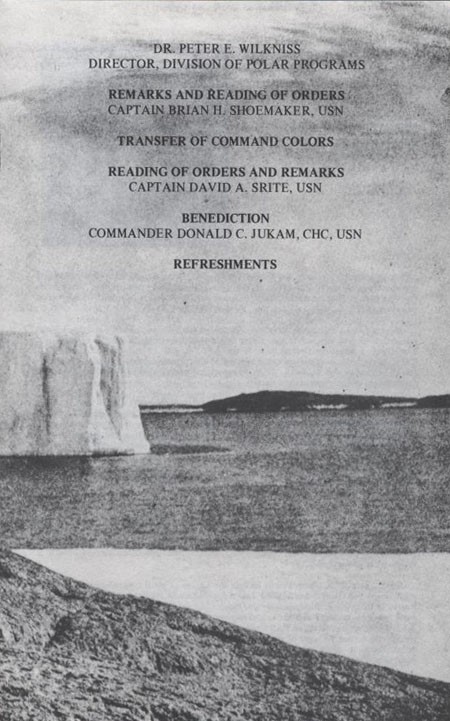
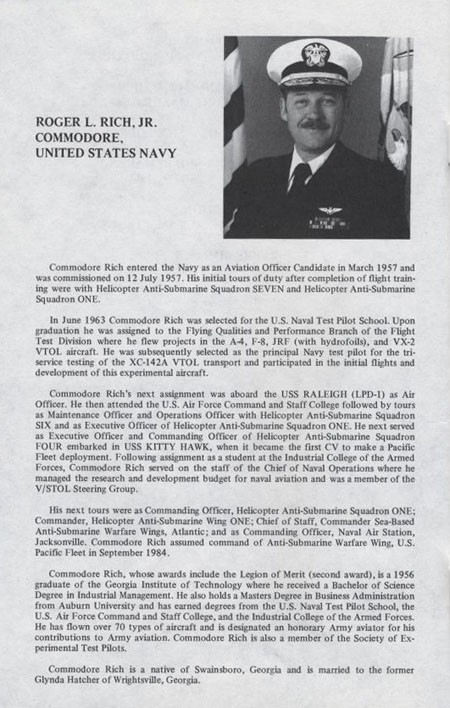
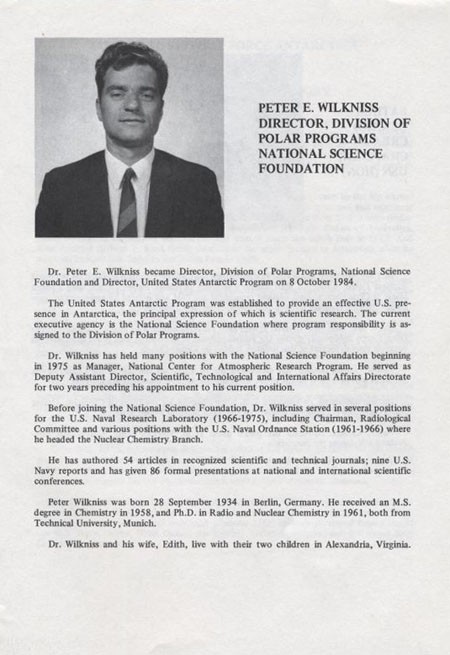
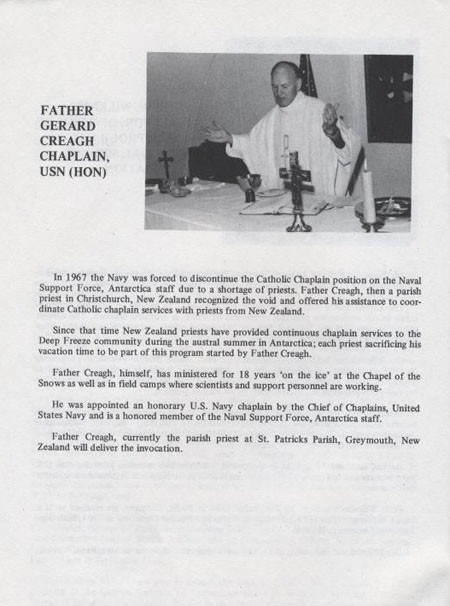
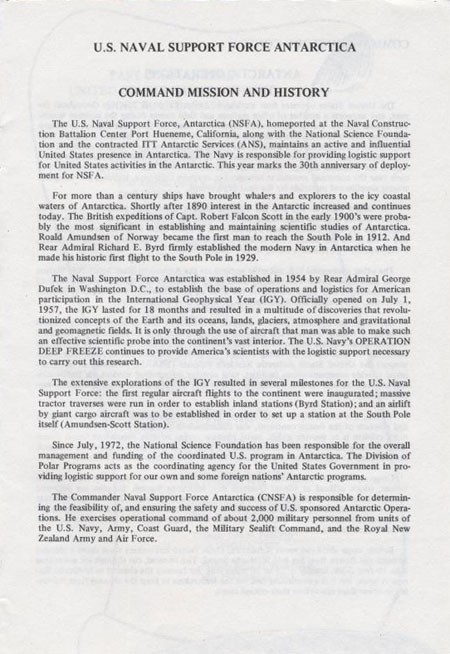
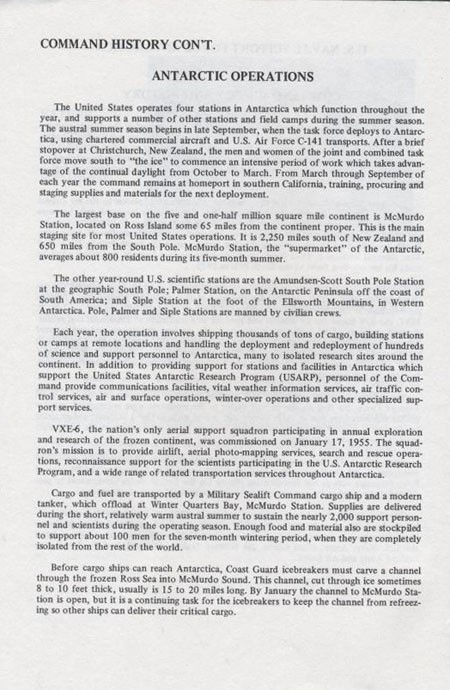
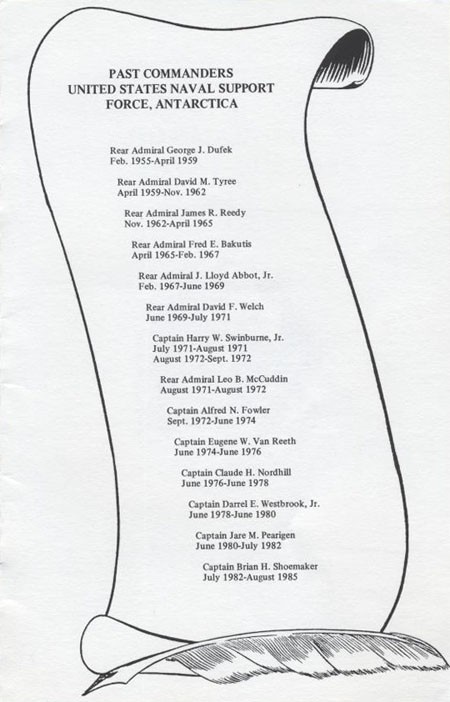
![OPERATION DEEP FREEZE [logo]. OPERATION DEEP FREEZE [logo].](/content/history/nhhc/research/library/research-guides/z-files/ze-places-files-in-the-navy-department-library/change-command-commander-usnaval-support-force-antarctica/_jcr_content/body/image_14.img.jpg/1473695020814.jpg)


